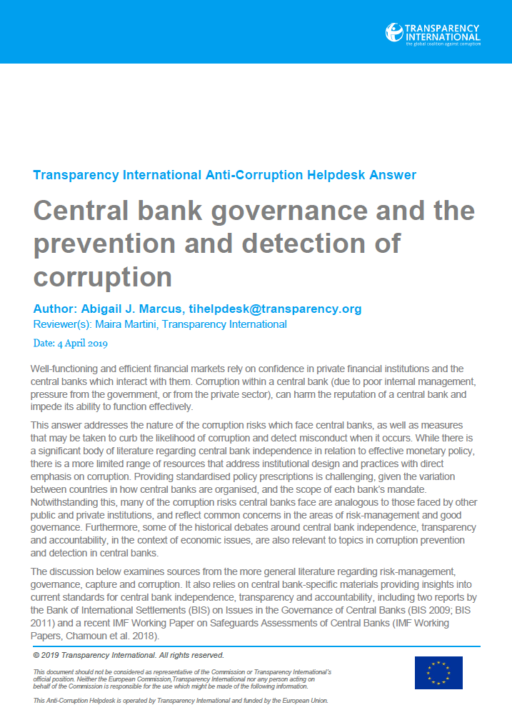- Home
- Anti-Corruption Helpdesk
- Central bank governance and the prevention and detection of corruption
Central bank governance and the prevention and detection of corruption

This Anti-Corruption Helpdesk brief was produced in response to a query from one of Transparency International’s national chapters. The Anti-Corruption Helpdesk is operated by Transparency International and funded by the European Union.
Query
What is the role of national central banks in preventing and countering corruption? In particular, we are interested in understanding good practices with regards to central bank governance and operations with a view to preventing and/or detecting corruption. We would appreciate an analysis of issues around: i) mandate, decision-making structure and the autonomy of central banks; ii) transparency and accountability frameworks; and iii) the internal control environment.
Summary
Well-functioning and efficient financial markets rely on confidence in private financial institutions and the central banks which interact with them. Corruption within a central bank (due to poor internal management, pressure from the government, or from the private sector), can harm the reputation of a central bank and impede its ability to function effectively.
This answer addresses the nature of the corruption risks which face central banks, as well as measures that may be taken to curb the likelihood of corruption and detect misconduct when it occurs. While there is a significant body of literature regarding central bank independence in relation to effective monetary policy, there is a more limited range of resources that address institutional design and practices with direct emphasis on corruption. Providing standardised policy prescriptions is challenging, given the variation between countries in how central banks are organised, and the scope of each bank’s mandate. Notwithstanding this, many of the corruption risks central banks face are analogous to those faced by other public and private institutions, and reflect common concerns in the areas of risk-management and good governance. Furthermore, some of the historical debates around central bank independence, transparency and accountability, in the context of economic issues, are also relevant to topics in corruption prevention and detection in central banks.
The discussion below examines sources from the more general literature regarding risk-management, governance, capture and corruption. It also relies on central bank-specific materials providing insights into current standards for central bank independence, transparency and accountability, including two reports by the Bank of International Settlements (BIS) on Issues in the Governance of Central Banks (BIS 2009; BIS 2011) and a recent IMF Working Paper on Safeguards Assessments of Central Banks (IMF Working Papers, Chamoun et al. 2018).
Contents
- Corruption risks in central banks
- Standards and good practices for mitigating corruption risks
- References and further reading
Main points
- Public trust in the integrity of central banks is critical to their effectiveness; corruption scandals undermine public trust.
- Central banks may face corruption risks from political institutions/government, industry and sources internal to the bank.
- Institutional and operational independence can serve as a bulwark against corruption and undue influence.
- Accountability mechanisms (including transparency, internal controls and external audits) can help central banks deter and detect corruption.
Authors
Abigail J. Marcus, [email protected]
Reviewer:
Maira Martini, Transparency International
Date
11/04/2019
Tags
 Download PDF
Download PDF
